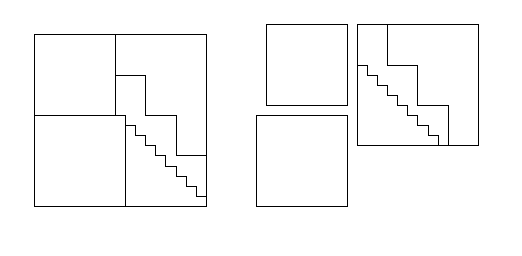
In Plate 28 Freese showed a dissection of a square into five pieces that could be rearranged to form either of two different isosceles triangles. Gavin Theobald noticed that Freese didn't need five pieces to perform this task, but only four, and in fact Freese had already shown most of the idea for this in the dissection on the right in the third row of Plate 27. You can form the other isosceles triangle by taking the isosceles triangular piece and also the three remaining pieces from this dissection to form a second isosceles triangle of the same size and sliding them together, placing the right angles next to each other, to form a larger isosceles right triangle. Do you see it now?
In Plate 39, Freese gave two dissections that he claimed to be unique. At the top of the plate he claimed that his dissection of squares of sidelengths 9, 12, and 20 to a square of sidelength 25 is the "only possible 5-piece squaring of three unequal squares." To demonstrate that this claim is false, I gave, in Figure I39a, a different 5-piece dissection of squares, this time of sidelengths 8, 9, and 12 to a square of sidelength 17. The dissection in Figure I39a turned out by chance not to be translational. Since Freese's original example was translational, I didn't mean to suggest that his original dissection might be a unique translational dissection. We can modify my dissection in Figure I39a to make it translational, as we see below. Thus Freese's translational dissection is also not unique.

Copyright 2018, Greg N. Frederickson.
Permission is granted to any purchaser of
Ernest Irving Freese's Geometric Transformations:
the Man, the Manuscript, the Magnificent Dissections!
to print out a copy
of this page for his or her own personal use.
Last updated February 18, 2018.